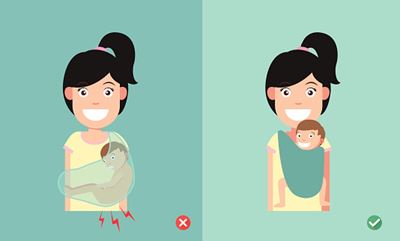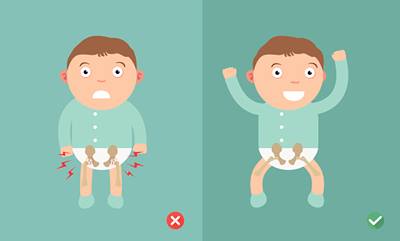How swaddling your baby the wrong way can lead to hip dysplasia
Most people aren’t familiar with the term “hip dysplasia.” This little known condition is the leading cause of hip arthritis in young women and accounts for 10% of all total hip replacements in the United States.
What is Hip Dysplasia?
Hip dysplasia means that the bones of the hip joint are not aligned correctly. This causes the joint itself to become loose and out of socket. Hip dysplasia can range from a shallow socket to a completely dislocated hip. Hip dysplasia in infants is painless even when the hip is completely dislocated. The outer edges of a baby’s hip are soft and flexible because they are made of cartilage like the cartilage in your ear. You can bend your ear without any pain and the hip can slip in and out of the socket of a baby without any pain. Pediatricians examine every baby to see if the hips are loose or dislocated. This examination can identify 90% of the cases of hip dysplasia so that treatment with a simple splint or harness can begin early.
How swaddling your baby the wrong way can lead to hip dysplasia
Recently, it has been discovered that infants whose hips were normal at birth may develop hip dysplasia because of improper swaddling during infancy. Improper swaddling is wrapping the baby with the legs straight out and pressed together in a tight bundle.


There are many ways to swaddle babies by using blankets or commercial products designed for swaddling. In order for swaddling to allow healthy hip development, the legs should be able to bend up and out at the hips. This position allows for natural development of the hip joints.
The baby’s legs should not be tightly wrapped straight down and pressed together. Swaddling infants with the hips and knees in an extended position may increase the risk of hip dysplasia and dislocation.
How to swaddle your baby the hip healthy way:
How to properly swaddle an infant
1. If using a square cloth, fold back one corner creating a straight edge.
2. Place the baby on the cloth so that the top of the fabric is at shoulder level. If using a rectangular cloth, the baby's shoulders will be placed at the top of the long side.
3. Bring the left arm down. Wrap the cloth over the arm and chest. Tuck under the right side of the baby.
4. Bring the right arm down and wrap the cloth over the baby's arm and chest.
5. Tuck the cloth under the left side of the baby. The weight of the baby will hold the cloth firmly in place.
Twist or fold the bottom end of the cloth and tuck behind the baby, ensuring that both legs are bent up and out. It is important to leave room for the hips to move.
Download our brochure on healthy swaddling.
What about sleepsacks and commercial swaddling products?
Some parents choose to wrap their babies in sleepsacks specifically designed for swaddling, instead of using a simple cloth or blanket. Commercial products for swaddling should have a loose pouch or sack for the baby’s legs and feet, allowing plenty of hip movement. However, even some of these commercial products can confine the legs if they are tightened around the thighs.
It's especially important to allow the hips to spread apart and bend up. In the womb the legs are in a fetal position with the legs bent up across each other. Sudden straightening of the legs to a standing position can loosen the joints and damage the soft cartilage of the socket.
Final thoughts
Traditional swaddling should be avoided due to the stress it can place on an infant’s hips. A joint that is out of place or shallow will wear out faster than one that has a more normal shape. Doctors often compare this is like the tread on a tire that is out of balance on a car. The tread wears out faster on a tire that is out of balance or out of alignment. However before the tire wears out completely, it can be rotated or re-balanced to increase the life of the remaining tread on the tire. Once the tread is gone, the tire needs to be replaced.
To learn more about hip dysplasia visit HipDysplasia.org







